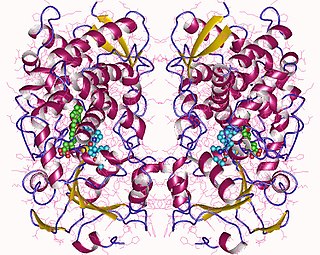
Modafinil, sold under the brand name Provigil among others, is a central nervous system (CNS) stimulant medication used to treat sleepiness due to narcolepsy, shift work sleep disorder, and obstructive sleep apnea. While it has seen off-label use as a purported cognitive enhancer to improve wakefulness in animal and human studies, the research on its effectiveness for this use is not conclusive. Modafinil is taken by mouth.

Nootropics are a wide range of natural or synthetic supplements or drugs and other substances that are claimed to improve cognitive function or to promote relaxation, particularly boosting mood, executive functions, attention, memory, creativity, or motivation in healthy individuals. The most commonly used nootropic in the world is caffeine.
A dopamine reuptake inhibitor (DRI) is a class of drug which acts as a reuptake inhibitor of the monoamine neurotransmitter dopamine by blocking the action of the dopamine transporter (DAT). Reuptake inhibition is achieved when extracellular dopamine not absorbed by the postsynaptic neuron is blocked from re-entering the presynaptic neuron. This results in increased extracellular concentrations of dopamine and increase in dopaminergic neurotransmission.

Cytochrome P450 3A4 is an important enzyme in the body, mainly found in the liver and in the intestine. It oxidizes small foreign organic molecules (xenobiotics), such as toxins or drugs, so that they can be removed from the body. It is highly homologous to CYP3A5, another important CYP3A enzyme.

Adrafinil, sold under the brand name Olmifon, is a wakefulness-promoting medication that was formerly used in France to improve alertness, attention, wakefulness, and mood, particularly in the elderly. It was also used off-label by individuals who wished to avoid fatigue, such as night workers or others who needed to stay awake and alert for long periods of time. Additionally, the medication has been used non-medically as a nootropic.

Valnoctamide has been used in France as a sedative-hypnotic since 1964. It is a structural isomer of valpromide, a valproic acid prodrug; unlike valpromide, however, valnoctamide is not transformed into its homologous acid, valnoctic acid, in vivo.

Armodafinil is the enantiopure compound of the eugeroic modafinil (Provigil). It consists of only the (R)-(−)-enantiomer of the racemic modafinil. Armodafinil is produced by the pharmaceutical company Cephalon Inc. and was approved by the U.S. Food and Drug Administration (FDA) in June 2007. In 2016, the FDA granted Mylan rights for the first generic version of Cephalon's Nuvigil to be marketed in the U.S.

Pinazepam is a benzodiazepine drug. It possesses anxiolytic, anticonvulsant, sedative and skeletal muscle relaxant properties.

Cytochrome P450 family 2 subfamily C member 9 is an enzyme protein. The enzyme is involved in metabolism, by oxidation, of both xenobiotics, including drugs, and endogenous compounds, including fatty acids. In humans, the protein is encoded by the CYP2C9 gene. The gene is highly polymorphic, which affects the efficiency of the metabolism by the enzyme.

Erdosteine is a molecule with mucolytic activity. Structurally it is a thiol derivative characterized by the presence of two thiol groups. These two functional sulfhydryl groups contained in the molecule are released following first-pass metabolism with the conversion of erdosteine into its pharmacologically active metabolite Met-I.

Medifoxamine, previously sold under the brand names Clédial and Gerdaxyl, is an atypical antidepressant with additional anxiolytic properties acting via dopaminergic and serotonergic mechanisms which was formerly marketed in France and Spain, as well as Morocco. The drug was first introduced in France sometime around 1990. It was withdrawn from the market in 1999 (Morocco) and 2000 (France) following incidences of hepatotoxicity.

Deramciclane (EGIS-3886) is a non-benzodiazepine-type anxiolytic drug to treat various types of anxiety disorders. Deramciclane is a unique alternative to current anxiolytics on the market because it has a novel chemical structure and target. It acts as an antagonist at the 5-HT2A receptor, as an inverse agonist at the 5-HT2C receptor, and as a GABA reuptake inhibitor. The two serotonin receptors are G protein-coupled receptors and are two of the main excitatory serotonin receptor types. Their excitation has been implicated in anxiety and mood. Deramciclane does not affect CYP3A4 activity in metabolizing other drugs, but it is a weak inhibitor of CYP2D6. Some studies also show the drug to have moderate affinity to dopamine D2 receptors and low affinity to dopamine receptor D1. Researchers are looking for alternatives to benzodiazepines for anxiolytic use because benzodiazepine drugs have sedative and muscle relaxant side effects.

Blonanserin, sold under the brand name Lonasen, is a relatively new atypical antipsychotic commercialized by Dainippon Sumitomo Pharma in Japan and Korea for the treatment of schizophrenia. Relative to many other antipsychotics, blonanserin has an improved tolerability profile, lacking side effects such as extrapyramidal symptoms, excessive sedation, or hypotension. As with many second-generation (atypical) antipsychotics it is significantly more efficacious in the treatment of the negative symptoms of schizophrenia compared to first-generation (typical) antipsychotics such as haloperidol.

Trimebutine is a drug with antimuscarinic and weak mu opioid agonist effects. It is used for the treatment of irritable bowel syndrome and other gastrointestinal disorders.

Taurolidine is an antimicrobial that is used to prevent infections in catheters. Side effects and the induction of bacterial resistance is uncommon. It is also being studied as a treatment for cancer.
Cyclooxygenases are enzymes that take part in a complex biosynthetic cascade that results in the conversion of polyunsaturated fatty acids to prostaglandins and thromboxane(s). Their main role is to catalyze the transformation of arachidonic acid into the intermediate prostaglandin H2, which is the precursor of a variety of prostanoids with diverse and potent biological actions. Cyclooxygenases have two main isoforms that are called COX-1 and COX-2. COX-1 is responsible for the synthesis of prostaglandin and thromboxane in many types of cells, including the gastro-intestinal tract and blood platelets. COX-2 plays a major role in prostaglandin biosynthesis in inflammatory cells and in the central nervous system. Prostaglandin synthesis in these sites is a key factor in the development of inflammation and hyperalgesia. COX-2 inhibitors have analgesic and anti-inflammatory activity by blocking the transformation of arachidonic acid into prostaglandin H2 selectively.
The eudysmic ratio represents the difference in pharmacologic activity between the two enantiomers of a drug. In most cases where a chiral compound is biologically active, one enantiomer is more active than the other. The eudysmic ratio is the ratio of activity between the two. A eudysmic ratio significantly differing from 1 means that they are statistically different in activity. Eudisimic ratio (ER) reflects the degree of enantioselectivity of the biological systems..For example, (S)-propranolol meaning that (S)-propranolol is 130 times as active as its - enantiomer.

Bioenhancers or biopotentiators or bioavailability enhancers is a new chapter in medical science first scientifically established in 1979 after the discovery of world's first bioenhancer piperine. It is a pocket friendly drug technology which reduces the destruction, wastage and elimination of several orally administered drugs inside the body.

Modafinil acid, also known as modafinilic acid or modafinil carboxylate, is one of the two major metabolites of modafinil – the other being modafinil sulfone. Modafinil acid is also a metabolite of the modafinil prodrug, adrafinil, and the (R)-(–)-enantiomer is a metabolite of armodafinil, the (R)-(–)-enantiomer of modafinil. Between 30 - 60% of modafinil is converted to modafinil acid and its half life is roughly half that of modafinil. Modafinil acid seems to be inactive, and similarly to modafinil sulfone, does not appear to contribute to the wakefulness-promoting/psychostimulant effects of modafinil.

Mevidalen (developmental code name LY-3154207) is a dopaminergic drug which is under development for the treatment of Lewy body disease, including those with Parkinson's disease. It acts as a selective positive allosteric modulator (PAM) of the dopamine D1 receptor. The drug is orally active and crosses the blood–brain barrier. It is a tetrahydroisoquinoline and is a close analogue of DETQ, another D1 receptor PAM. Mevidalen has been found to have wakefulness-promoting effects in sleep-deprived humans. Side effects of mevidalen have been reported to include increased heart rate and blood pressure, insomnia, dizziness, nausea, vomiting, anxiety, nervousness, fatigue, headaches, palpitations, and contact dermatitis, as well as falls in those with dementia. As of March 2022, mevidalen is in phase 2 clinical trials for the treatment of Lewy body disease. Besides for movement disorders and dementia, D1 receptor PAMs like mevidalen might have value in the treatment of certain neuropsychiatric disorders, such as depression, excessive somnolence, and attention deficit hyperactivity disorder.

















